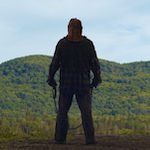 IN A VIOLENT NATURE was one of this year’s most hyped and intriguing indie horror movies. It’s a slasher hailing from the land of Canada (see also: BLACK CHRISTMAS, PROM NIGHT, MY BLOODY VALENTINE), but it it takes an unusual approach that made some describe it as an “ambient slasher” or “slow cinema” after its midnight Sundance premiere. Writer/director Chris Nash cited Gus Van Sant’s camera-following-people-walking-around trilogy and Terrence Malick as inspirations, while many reviews compare the style to the Dardenne Brothers and Bela Tarr. So when I finally saw it on Shudder I was surprised that it’s much closer to a normal slasher movie than the arty deconstruction or reinvention I’d pictured from all that.
IN A VIOLENT NATURE was one of this year’s most hyped and intriguing indie horror movies. It’s a slasher hailing from the land of Canada (see also: BLACK CHRISTMAS, PROM NIGHT, MY BLOODY VALENTINE), but it it takes an unusual approach that made some describe it as an “ambient slasher” or “slow cinema” after its midnight Sundance premiere. Writer/director Chris Nash cited Gus Van Sant’s camera-following-people-walking-around trilogy and Terrence Malick as inspirations, while many reviews compare the style to the Dardenne Brothers and Bela Tarr. So when I finally saw it on Shudder I was surprised that it’s much closer to a normal slasher movie than the arty deconstruction or reinvention I’d pictured from all that.
Yes, the approach is inspired by the above-named filmmakers, but this is not some self-serious, nihilistic chiller. It winkingly repurposes arthouse techniques for pulpy purposes. Alex Nino Gheciu of the Globe and Mail wrote that the film “has no protagonists. Everything is shown from [the killer’s] perspective,” which puts in mind the opening of THE TOOLBOX MURDERS, but it’s not that either. You have your usual characters, they’re just not at center frame the whole time.
Pretty much all the traditional elements of a FRIDAY THE13TH wannabe are here. We have a group of college kids visiting some woods in Ontario, some know the local legend of Johnny (Ry Barrett, BEYOND THE CHAMBER OF TERROR), a developmentally disabled kid who was killed in a cruel prank gone wrong. There was a coverup, a revenge, a curse. He has a meaningful object given to him by his mother and a trademark mask. There’s a character named Kris (Andrea Pavlovic, WELL SUITED FOR CHRISTMAS, DESIGNING CHRISTMAS) who ends up being the final girl and uses what she learns about him to try to escape. It’s a normal (if somewhat simplistic) slasher movie story, it’s just that much of the expository or plot-advancing dialogue is heard from out of frame or from a distance.
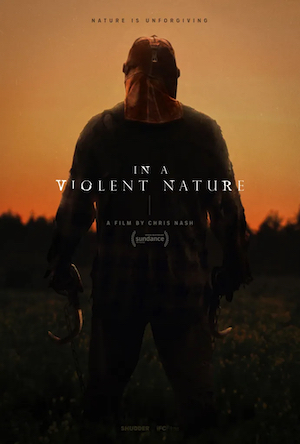 To be fair there are also plenty of scenes where we spend time with Johnny before and after what would traditionally be seen in a slasher movie, and that’s part of what makes it feel fresh. But mainly it’s a movie that reverses the traditional horror movie perspective. Instead of following the victims and then sometimes switching to the killer in the bushes looking in the window, it’s the other way around. I don’t think it’s radical, it’s just a good gimmick, a novelty that makes this a memorable take on the subgenre. Which I’m all for.
To be fair there are also plenty of scenes where we spend time with Johnny before and after what would traditionally be seen in a slasher movie, and that’s part of what makes it feel fresh. But mainly it’s a movie that reverses the traditional horror movie perspective. Instead of following the victims and then sometimes switching to the killer in the bushes looking in the window, it’s the other way around. I don’t think it’s radical, it’s just a good gimmick, a novelty that makes this a memorable take on the subgenre. Which I’m all for.
In the opening scene our off-camera main characters find a locket hanging in the woods, and Troy (Liam Leone, one episode of Eli Roth Presents: A Ghost Ruined My Life) takes it. They of course have no idea that the necklace being placed at Johnny’s death site is what keeps his soul at rest; immediately after they leave his resurrected corpse crawls out of the ground and starts stumbling through the woods looking for it. He never talks, and we mostly see him from the back, so it’s easy to forget he’s not Jason.
The most striking choice is that there’s no musical score. The movie’s most repeated image is Johnny’s back as he walks through the woods, like we’re playing him in a video game, and when there’s not a scene with other characters going on nearby we hear the birds and crickets and other nature sounds all around him, it’s very immersive. He’s gotta be the cinematic slasher whose footsteps we hear the most. It’s kind of nice that it’s a horror movie but also a peaceful nature walk. Two birds with one stone.
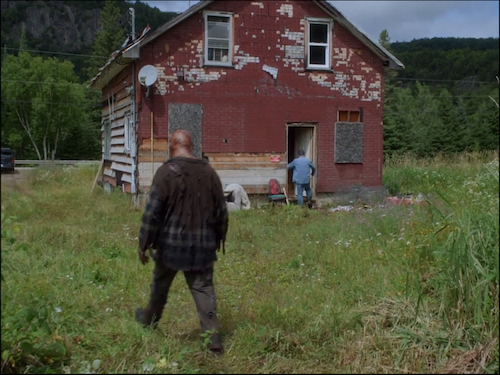
One thing that’s always funny in the movie, but pretty believable, is how often we see him approaching people and they’re just not looking in his direction and don’t notice him at all. He comes upon a dispute between a park ranger (Reece Presley, CHRISTMAS IN ANGEL FALLS, SANTA’S CASTLE) and a local named Chuck (Timothy Paul McCarthy, ABCs OF DEATH 2), and neither of them see him at first. The same thing happens later with two of our youths. Too involved in their macho bullshit to see Death coming for them. The part where Johnny follows Chuck (until he ironically steps in one of his illegal traps the ranger was warning him about) is really exciting as a slasher fan because we’ve seen this exact scene 1.2 million times but it’s always the camera on Chuck as he huffs and cries and falls, sensing that Johnny is behind him and catching up. Here we stay on slow walking Johnny and hear Chuck’s voice getting quieter as he runs off camera.
I think this is clearly a funny movie, but sometimes people argue with me on that stuff, so I will point them to the part where he mistakes Chuck’s necklace for the one he’s looking for but it turns out Chuck’s is engraved “#1 MOTHER FUCKER.” Nevertheless (or therefore?) it gives Johnny a warm memory of his mother.
Ehren (Sam Roulston) knows the story of Johnny and “the White Pines Slaughter” that happened here 70 years ago, so 15 minutes in we actually get a normal perspective with the camera rotating around them as they discuss it at the campfire, FRIDAY THE 13TH PART 2 style. In the next scene it goes back to Johnny watching them in the cabin as they argue, take off their clothes, go out on the porch to smoke, etc., but that’s a familiar horror movie point of view. Where it does stray from standard procedure is after the first really spectacular kill we get an unusual amount of screen time dedicated to Johnny dragging the body away and leaving the head somewhere. Later there’s a scene where he slowly pulls a corpse by chain into a shed with a noisy log-splitter running. He first tests the machine on a log, then uses it to cut off a hand, then the poor guy wakes up and starts blinking as the thing slowly chops off his head (seamlessly done in one shot).
That whole sequence takes almost 7 minutes. It has an obvious climax where they could cut away on a high, but instead they leave it running as Johnny stands awkwardly over the body for a bit. I think it’s an intentional provocation, and a funny one. We know from the obvious indisputable highlight of the movie, a cartoonishly over-the-top kill you’ll have to see for yourself, that Nash has a strong grasp of tension and release, setup and punchline, but also likes to linger in the discomfort, like a Norm MacDonald joke. I’m positive that many audiences hooted and cheered at the preposterous way he kills that poor lady, but I wonder if they continued to titter through the subsequent 35 seconds of quiet as he looks at the body, picks up the hooks and chain that he did the damage with, holds them for a bit?
Despite these strategic stretches of performative tedium, I don’t think Nash wants to punish his audience. Even the walking sequences get a sense of momentum from their many jump cuts, and the movie’s only 93 minutes including credits. Whatever pretentiousness may be implied by the influences being name dropped, this is clearly the work of Fangoria kids bringing back that Tom Savini era spirit of trying to top what’s been done before. It’s a pretty low body count, but each kill is designed to reward your patience, and there’s some really great dark humor with Johnny going so overboard he gets back onto the boat and then goes overboard again.
There’s one really funny observation I heard about the movie that I almost wish I could forget, but I’m gonna share it with you anyway. Somebody said that the antique firefighter mask he wears makes him look like a Minion. It’s hard to unsee. But I’m not sure how scary he’s really supposed to be anyway. Sometimes the cutaways to the mask imply a comical reaction. It gives him a little bit of personality to distinguish him from his genre forefathers.
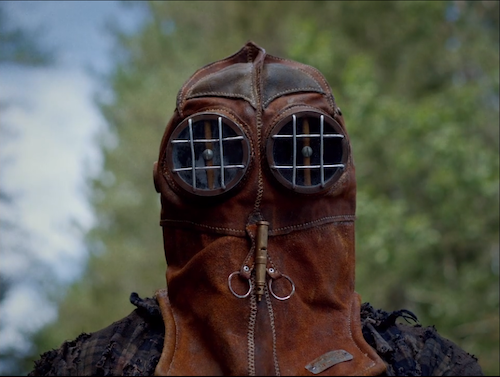
We do see his face, and I think it adds some weight to him, even though he spends the scene sitting on the ground playing with a Hot Wheels keychain he found while his future victims are arguing nearby.
It’s a good looking movie, and well made. Some of the ADR acting can be slightly awkward, but it’s a good cast of unknowns, with Pavlovic in particular having the strong screen presence you need for lightly sketched characters like this to work. It’s not a period piece (a character mentions cancel culture) but the faces would work for one.
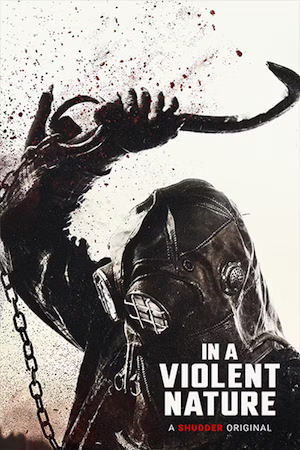 The more I write about IN A VIOLENT NATURE the more I appreciate it, but I admit there’s something that keeps me stuck at just liking it as opposed to really liking it: I just don’t get the ending. (ENDING SPOILERS THIS PARAGRAPH.) I appreciate the extended look at the “picked up by a good samaritan” trope, with Lauren-Marie Taylor (from both FRIDAY THE 13TH PART 2 and GIRLS NITE OUT!) giving Kris a ride to the hospital and a long story about her brother getting mauled by a bear. But even after rewatching it the defiantly uneventful conclusion feels like a betrayal of the rest of the movie’s “we’re gonna take our sweet time, but we’re gonna get somewhere” ethic. It cuts to the credits on a shot that feels like an “Oh shit!” but for me was a “Hm.” On further analysis I understand that she left Johnny’s locket on the gas canister and now it’s gone. I think the idea is that he took it and left, so it’s a good thing she ran instead of staying to fight. But I guess I’m a dummy who wants to end a movie like this pumping my fist instead of scratching my head.
The more I write about IN A VIOLENT NATURE the more I appreciate it, but I admit there’s something that keeps me stuck at just liking it as opposed to really liking it: I just don’t get the ending. (ENDING SPOILERS THIS PARAGRAPH.) I appreciate the extended look at the “picked up by a good samaritan” trope, with Lauren-Marie Taylor (from both FRIDAY THE 13TH PART 2 and GIRLS NITE OUT!) giving Kris a ride to the hospital and a long story about her brother getting mauled by a bear. But even after rewatching it the defiantly uneventful conclusion feels like a betrayal of the rest of the movie’s “we’re gonna take our sweet time, but we’re gonna get somewhere” ethic. It cuts to the credits on a shot that feels like an “Oh shit!” but for me was a “Hm.” On further analysis I understand that she left Johnny’s locket on the gas canister and now it’s gone. I think the idea is that he took it and left, so it’s a good thing she ran instead of staying to fight. But I guess I’m a dummy who wants to end a movie like this pumping my fist instead of scratching my head.
Still, I recommend IN A VIOLENT NATURE to all interested parties. And by the way, writer/director Nash was the creature effects supervisor for PSYCHO GOREMAN (which is a hell of a credit), while PSYCHO GOREMAN director Steven Kostanski was the prosthetic makeup effects lead on this. So those Canadian makeup FX guys are up to some stuff up there. I hope they keep the ball rolling.
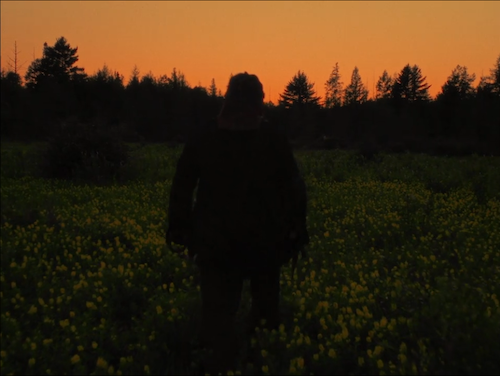


























October 9th, 2024 at 5:48 pm
SPOILERS, I’M SURE
Win or lose, I’m glad you watched and reviewed this one, but I’m extra-glad you liked it, and under not loving it. From the reading around I did, the ending good samaritan, seems to have elicited a reaction somewhere in the “divisive” to “infuriating and dumb as hell” range of the continuum. I actually liked it, but what do I know. I really liked the TCM vibes of the run through the woods at the end, and I really dug the amount of personality and ranges of mood they gave Johnny. Like the stuff with the hot wheels, or when he rousts the one kid out of his house, or the way he goes revenge HAM with the log splitter, or how he just goes into this cathartic rage kill for his last kill. There’s a good range of weird Johnny emotionality / psychology being explored there, and I really enjoyed watching Johnny do his thing, watching characters react to him.
For me, the very end seemed like a pretty clear homage to HALLOWEEN 1, where you’re sort of just panning over his dominion, knowing he’s out there somewhere.
Personal highlights of this review are you analogizing the film to a Norm joke and the phrase “strategic stretches of performative tedium.” Great stuff.